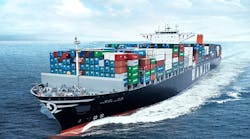As trucks are busy restocking stores in reacting to COVID-19, capacity available for other products is causing a historically tight trucking market that has dropped 20% in volume in just the last two weeks, according to ABI Research.
“Rising costs, shrinking capacity, and panicked customers are shaking up the freight transportation and logistics markets,” says Susan Beardslee, Principal Analyst at ABI Research.
The American Association of Port Authorities sees 1Q volume decreased by at least 20%, including blank sailings, which may cost carriers $1.9 billion.
Rail freight is also impacted with intermodal down by approximately 50%, including from California’s Long Beach and Los Angeles ports (the leading container ports in the United States and the busiest in the Western Hemisphere).
Global air cargo volumes for the last month are expected to be down 9%. New restrictions on passenger travel from much of Europe to the United States will further affect air cargo capacity. DHL alone is reporting an impact of $79 million to February earnings. All of this adds to the already existent decreases due to the China-U.S. tariff tensions.
“In the short term, there has been more than a six-week delay in shipments for cargo sourced from China," said Beardslee. "Other markets from Vietnam to Mexico often rely on Chinese components and raw materials, creating a knock-on effect to the supply chain, including transportation and logistics. The initial loss of road transport demand has begun in the ports and is moving to the warehouses and inland routes. Cargo capacity demand in China is beginning to demonstrate some initial signs of growth, with airfreight between China and the United States growing 27% over the last 14 days, creating a demand/supply imbalance."
This capacity challenge will move to containers (stranded outside of China) and trucks. However, as the virus has continued to spread outside of China, government actions have included restrictions on travel from 26 European countries to the United States.
“Belly cargo” (air cargo) is transported via passenger flights, estimated to be 50% of all air cargo. When this capacity is drastically removed between Europe and the United States, availability will be significantly impacted and spikes in pricing are expected.
“In the longer term, there is little visibility to forecast, which will have a material impact on transportation and logistics this year. The virus is now impacting the global supply chain, with a current estimate of 113 countries identified as reporting cases. Transportation requirements will be hard to predict. Both capacity and pricing swings are anticipated across transportation modes, with the associated impact to shippers worldwide,” says Beardslee.
Shippers need to evaluate options and model changes across modes of transportation, considering interruptions, delays, and significant price increases. Both manufacturers and retailers need to develop prioritization plans for customers, potentially with set limits per customer. Systems integration whenever possible (ERP, Transportation Management System (TMS), Warehouse Management System (WMS)), along with predictive analytics/scenario modeling, is ideal.
“Finally, keep in mind that as some countries begin to scale up production and transportation, others may move into containment strategies to address an outbreak. This will require near-real-time visibility across modes and the flexibility to adjust everything from inventory quantities and locations to substitution whenever possible,” Beardslee advises.



